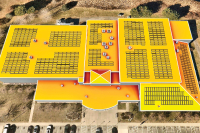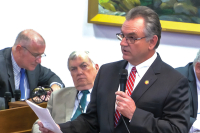Trail improvements coming to Fontana: Work begins on $380K trail project
 National forest trails around Fontana Village are in for an overhaul, thanks to a federal grant that’s putting the final piece in a years-long funding puzzle.
National forest trails around Fontana Village are in for an overhaul, thanks to a federal grant that’s putting the final piece in a years-long funding puzzle.
Between 2013 and 2015, the U.S. Forest Service has pulled in a total of $380,000 in grants to work on the area, but it’s just now getting going on the project the money was intended to support — 9 miles of upgraded trails in the Nantahala National Forest that will connect to the roughly 28 miles of trail that Fontana Village Resort, in Graham County, maintains on its own property.
“We’re doing some thinking within our recreation program about how we can make some different recreation opportunities more visible and easier for the general public to identify,” said Angela Gee, district ranger for the Cheoah and Tusquitee districts of the Nantahala.
Administered by the N.C. Division of Parks and Recreation, the Recreational Trails Program — which supplied the funding — aims to support projects that expand recreational opportunities for everything from hiking to off-road driving while promoting resource-based tourism. This year’s grants totaled $6 million, dispersed between 35 North Carolina counties.
The forest surrounding Fontana Dam, a tiny municipality built around Fontana Village Resort, was a logical focus for Gee, whose districts encompass some of the most remote reaches of the Nantahala National Forest. The Appalachian Trail passes right through the town, and with Fontana Dam earning designation as an A.T. Community this spring, the area stands to capitalize on expanded recreation opportunity.
“It’s putting Fontana Village a little more on the map and (we’re) just really seeing an opportunity with this program to secure some funding to address some of the trail issues,” Gee said of the designation, given by the nonprofit Appalachian Trail Conservancy.
Related Items
Specifically, issues such as user-created trails that lead to erosion and impact habitat, and bridges just waiting to cause an accident. The project will include replacing bridges throughout the 9 trail miles involved, winnowing down a maze of user-created trails connecting Fontana Village and the national forest to a few official ones on Forest Service land and upgrading the trails to accommodate horses, hikers and bikers — right now, they’re designated only for hikers, though some bikers venture out that way.
Both the 2013 grant — a $200,000 award for Fontana Loop Trail No. 157 — and the 2014 grant — an $80,000 award for Bee Cove Trail No. 421 — involve bridge replacements. All three, including the 2015 grant of $100,000 to upgrade user-created trails connecting Fontana Village and Fontana Loop Trail, will involve upgrading the paths to multi-use trails.
“Overall, one of the biggest purposes for doing this work is to convert the trails from a single use to new multi-use trails,” Gee said. “They used to just be hiking trails, and we are converting them to hiking, biking and equestrian trails.”
Bikers do sometimes use the trails as they are, but because of the rickety bridges along the way, that can be dangerous, said Fontana Village’s recreation director Jonathan Peoples.
“I weigh 150 pounds, and they would wobble when I walked across them,” Peoples said of the bridges. “I would get off the bike and walk across all three of them.”
Connectivity is another big incentive to complete the project, Gee said. By upgrading the Forest Service trails and tying them in better with the Fontana Village trails, users will wind up with a much larger network to explore.
“Connecting trails on national forest system land is always a plus,” she said.
The work won’t be completed overnight. Even though the Forest Service has landed grants for both 2014 and 2015, it doesn’t yet have those funds in hand. Work has just begun on the Fontana Loop Trail, the project funded with the 2013 grant. Those upgrades are likely to finish in early 2016, delivering a 3-mile multi-use trail connecting to Fontana Village and sporting several new bridges and a relocated trail section for increased safety.
Once the grant funds come through for the 2014 and 2015 projects, the Forest Service will have two years to complete the work. That means that the Bee Cove Trail project will likely finish up in 2017 and the upgrades of user-created trails around Fontana Village will likely be complete in 2018.
With lots of forest to explore, there are plenty more opportunities for trail development in the Nantahala, but Gee said she’s waiting on the outcome of the Forest Management Plan to think much beyond the 9 miles for which the Cheoah district currently has funding. The management plan, a final version of which is scheduled for release in 2017, has been in development since 2014. Its pages will contain the blueprint for the next two decades of recreation, conservation, tourism and a host of other activities, in the national forest.
But in the meantime, she’s excited about this project and the new opportunities it will soon provide.
“More people are able to get out on those trails and use them,” she said, “so that’s kind of a key aspect.”
More trail projects on the horizon
The Fontana Village area wasn’t the only spot to get funding under the most recent granting cycle from the federal Recreational Trails Program, administered by the N.C. Division of Parks and Recreation.
Funding also went to:
Ivestor Gap/Graveyard Ridge Trail Project, phase two. A $100,000 grant to the Pisgah National Forest will fund renovation and maintenance of a 2-mile section of the Graveyard Ridge Trail, a popular route accessible from the Graveyard Fields Overlook at mile 418.8 of the Blue Ridge Parkway’s Haywood County section. The work will address failed culverts, washouts and drainage issues.
Backwell Gap Horse Trail. A $50,000 grant will help pay for an environmental analysis looking at rerouting the popular equestrian trail in the Standing Indian Area of the Nantahala National Forest near Franklin. During heavy rains, water often floods a trail section that runs parallel to Long Branch. A reroute would fix the problem but requires an analysis under the National Environmental Policy Act. The reroute, if allowed, would be about 1.25 miles long.









